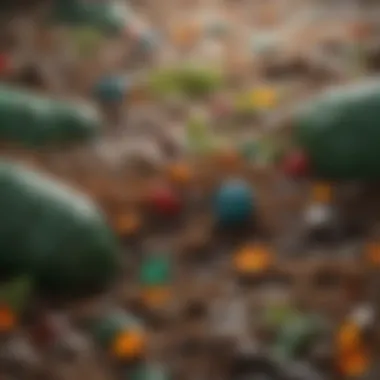Compostable Plastics: Future Directions and Viability


Intro
Compostable plastics are gaining attention as society grapples with the growing problem of plastic pollution. These materials are designed to biodegrade under specific conditions, contrasting sharply with conventional plastics that can remain in the environment for centuries. Understanding compostable plastics involves examining their materials, production processes, and potential environmental benefits.
The conversation around compostable plastics is relevant for students, researchers, educators, and industry professionals alike. This readership must explore the characteristics of these innovative materials, alongside their viability, and the challenges they face in the market.
Compostable plastics typically utilize renewable resources, such as corn starch or sugarcane, making their production potentially more sustainable than fossil-fuel based plastics. The materials used can be differentiated based on their composting conditions, which can be industrial or home-based.
As interest grows in sustainable alternatives, understanding the inherent trade-offs is paramount. While compostable plastics offer advantages, their adoption does carry implications for waste management systems and consumer behavior. This exploration aims to critically assess these elements, providing insights into future directions for research and development in the field.
Preface to Compostable Plastics
Understanding compostable plastics is becoming increasingly crucial as society grapples with escalating plastic pollution. These materials not only offer an alternative to traditional plastics but also hold the potential for more sustainable waste management solutions. As consumers and industries seek environmentally friendly options, compostable plastics present a viable pathway toward reducing the negative impact of plastic waste. Factors such as biodegradability, production methods, and applications are central to this discussion.
Definition and Overview
Compostable plastics are defined as materials that can break down into natural substances in a composting environment. Unlike conventional plastics that persist for centuries, these materials decompose more rapidly, typically within a few months. The core principle of compostability is that these plastics harmonize with organic matter, resulting in nutrient-rich compost suitable for soil enhancement. Examples include polylactic acid (PLA) and polyhydroxyalkanoates (PHA). It is crucial to distinguish between biodegradable and compostable, as the latter requires specific conditions for effective breakdown.
Key benefits of compostable plastics include:
- Reduced environmental footprint compared to traditional plastics.
- Contribution to organic matter in compost.
- Potential reduction in landfill waste.
Despite these advantages, it is imperative to consider the production processes and the sourcing of raw materials, as some compostable plastics might rely on agricultural inputs that could pose other environmental concerns.
Historical Context
The evolution of compostable plastics is a response to growing awareness of plastic waste issues. The early development of bioplastics dates back to the 20th century. However, substantial momentum began in the late 1990s and early 2000s, as consumer demand for sustainable products surged. The introduction of PLA, made from corn starch, marked a significant milestone in the industry.
Over the years, innovations have led to a broader variety of materials. These advancements parallel increased regulatory scrutiny over plastic waste and a societal shift towards sustainable practices. Many countries are now implementing legislation to promote or mandate the use of compostable materials in various sectors. This historical trajectory illustrates the interplay between technological advancement and environmental awareness, shaping the landscape for compostable plastics today.
"The trend towards compostable plastics reflects a significant cultural shift towards sustainability and innovation in materials science."
Understanding Traditional Plastics
The relevance of understanding traditional plastics lies in their pervasive use and the challenges they pose to our environment. Plastics, specifically petroleum-based ones, dominate various industries due to their versatility, low cost, and durability. However, their attributes that make them appealing also result in significant drawbacks. The contrast with compostable plastics becomes clearer when traditional plastics are examined comprehensively.
Types of Conventional Plastics
Conventional plastics can be categorized into several types, each serving distinct purposes:
- Polyethylene (PE): Commonly used in bags, bottles, and packaging materials. It is lightweight and resistant to moisture.
- Polypropylene (PP): Often found in containers, automotive parts, and textiles. It offers durability and resistance to chemicals.
- Polyvinyl Chloride (PVC): Utilized in plumbing, electrical cable insulation, and flooring. The flexibility and toughness are notable.
- Polystyrene (PS): Frequently used for disposable cutlery, insulation, and food packaging. It can be solid or foamed.
- Polyethylene Terephthalate (PET): Widely used in beverage bottles and food packaging. It is strong and resistant to impact.
Each type of plastic has specific characteristics, making them suitable for diverse applications. Their longevity, however, raises critical questions about waste management and environmental impact.
Environmental Challenges
The environmental challenges associated with traditional plastics are significant. One major issue is the longevity of these materials. Plastics can take hundreds of years to decompose, leading to accumulating waste in landfills and oceans. This persistence contributes to serious ecological disruptions and health hazards for wildlife.
Additionally, the production process of conventional plastics is energy-intensive and often relies on fossil fuels, contributing to air pollution and greenhouse gas emissions. The concerns elevate when considering microplastics, tiny plastic particles that result from the breakdown of larger plastic items, which infiltrate ecosystems and enter food chains.
"Plastics pose serious threats not only to the environment but also to human health as they can leach harmful chemicals into soil and water."
In light of these environmental challenges, exploring alternatives such as compostable plastics becomes increasingly vital. Understanding the shortcomings of traditional plastics is essential in appreciating the potential benefits of biodegradable options. This understanding lays the groundwork for the ongoing dialogue on sustainability and innovation needed to address the plastic pollution crisis.
Materials Used in Compostable Plastics
The exploration of materials used in compostable plastics forms a central part of understanding their viability and future directions. These materials determine not only the functionality of compostable plastics but also their environmental impact. Each material has unique properties that contribute differently to degradation processes. This section will cover three main types of materials commonly employed in the production of compostable plastics: biopolymers and blending techniques.
Biopolymers
Biopolymers are a fundamental category since they are derived from renewable biological resources. Their relevance in the production of compostable plastics stems from their capability for degradation under specific conditions. The most prevalent biopolymers include PLA (Polylactic Acid), PHA (Polyhydroxyalkanoates), and starch-based polymers. Understanding these materials will help assess how they contribute to tackling plastic waste challenges.


PLA (Polylactic Acid)
PLA, made from renewable resources like corn starch, serves as a significant player in the compostable plastic landscape. Its key characteristic is its ability to decompose into natural substances, making it an attractive option for environmentally conscious applications. This unique feature allows PLA to be used in various fields, most notably in packaging and disposable items.
However, while PLA presents several advantages, such as a relatively low production cost and favorable mechanical properties, it has its limitations. PLA requires specific conditions for degradation—typically industrial composting facilities—where temperatures exceed typical home composting environments. Thus, its environmental sustainability is contingent upon the presence of adequate composting infrastructure.
PHA (Polyhydroxyalkanoates)
PHA is another remarkable biopolymer that is produced by microorganisms through the fermentation of organic materials. This material's key characteristic is its versatility, as it can be tailored to exhibit different physical properties. PHA is gaining popularity due to its similar properties to conventional plastics, making it suitable for a wide range of applications.
One unique feature of PHA is that it biodegrades in various environments, including marine settings. This benefit positions PHA as a favorable option in addressing oceanic plastic pollution. However, the production cost of PHA is generally higher than that of PLA, which poses challenges for scalability and widespread adoption.
Starch-based Polymers
Starch-based polymers represent another category that plays an essential role in compostable plastics. These polymers are primarily derived from starch, a readily available and inexpensive biopolymer. Their key characteristic lies in their biodegradability, which can occur in both composting and landfill environments.
Starch-based polymers are particularly beneficial for short-lived products, such as food packaging, due to their ability to break down quickly after use. However, they may have limited mechanical properties and thermal stability compared to other biopolymers. As such, they may not be suitable for all applications, which necessitates careful consideration regarding their use in more demanding contexts.
Blending Techniques
Blending techniques involve combining various materials to optimize the properties of compostable plastics. By mixing biopolymers with other substances, manufacturers can enhance durability, processability, and performance under specific conditions. Such techniques lead to customized solutions that cater to different market requirements.
Considerations in blending include compatibility between materials, degradation rates, and overall impact on the end-of-life characteristics. The choice of blending ratios and methods can significantly influence the success of compostable plastic products. It is crucial for manufacturers to find the right balance that maintains biodegradability while improving functionality.
Biodegradation Processes
The exploration of biodegradation processes is vital in understanding compostable plastics and their role in reducing plastic pollution. Biodegradation refers to the breakdown of materials by microorganisms, leading to simpler, non-toxic compounds. This process is significant because it addresses the environmental impacts of traditional plastics, which can take centuries to decompose. Compostable plastics are designed to mimic natural processes, breaking down into organic matter under specific conditions.
Composting Definition
Composting is a natural process that converts organic waste into a nutrient-rich soil amendment or compost. It relies on the activity of microorganisms, such as bacteria and fungi, which decompose organic material. The composting process can occur in various environments, from backyard compost bins to large-scale industrial facilities. In the context of compostable plastics, composting provides an eco-friendly alternative to landfilling. For materials to be classified as compostable, they must break down within a defined timeframe into non-toxic byproducts.
Microbial Action and Breakdown
Microbial action is the driving force behind biodegradation. Microorganisms play a critical role in breaking down complex polymers found in compostable plastics. This breakdown occurs through enzymatic activities where specific enzymes act on polymer chains, converting them into simpler molecules.
- Factors influencing microbial activity include:
- Temperature: An optimal range typically between 50-65°C is ideal for microbial growth.
- Moisture: Sufficient moisture levels are necessary for microbial survival and efficiency.
- Oxygen availability: Aerobic conditions tend to enhance the degradation rates in composting systems.
The presence of diverse microbial communities can enhance the breakdown of various compostable materials. Research continues to focus on designing plastics that are more amenable to microbial breakdown.
Timeframes and Conditions for Degradation
Understanding the timeframes and conditions for the degradation of compostable plastics is essential for both manufacturers and consumers. Typically, compostable materials are expected to decompose within 90 to 180 days in an industrial composting environment.
- Key conditions for effective degradation include:
- Temperature control: Maintaining optimal heat levels is important for promoting microbial activity.
- Aeration: Ensuring adequate oxygen levels prevents anaerobic conditions that slow down the process.
- C/n Ratio: The Carbon to Nitrogen ratio affects microbial growth; a ratio of about 30:1 is often ideal.
The awareness of these factors allows businesses and composting facilities to optimize their practices, ensuring that compostable plastics do not contribute to pollution and instead support a more sustainable waste management system.
"The efficacy of compostable plastics in reducing waste hinges on the? understanding of biodegradation processes and proper composting conditions."
By promoting an understanding of biodegradation processes, improvements can be made in both the design of compostable plastics and the systems that support their composting, ultimately contributing to more sustainable environmental practices.
Regulatory Framework for Compostable Plastics
The regulatory framework surrounding compostable plastics is crucial for their successful integration into the market. It serves to establish guidelines that ensure these products meet certain environmental and safety standards. As the awareness of plastic pollution grows, countries and regions are actively developing their own rules to govern the production, testing, and marketing of compostable plastics.
The significance of a robust regulatory framework cannot be overstated. It not only facilitates consumer confidence but also encourages innovation within the industry. By mandating that compostable plastics meet specific certifications, companies are incentivized to invest in research and development. This is necessary for creating materials that will genuinely break down in composting conditions rather than simply pretending to do so.


Furthermore, regulations help clarify the distinction between compostable plastics and traditional plastics. This clarity is essential for both manufacturers and consumers, as it resolves confusion over what materials are genuinely environmentally friendly.
International Standards
International standards play a vital role in ensuring that compostable plastics are assessed uniformly across different markets. Bodies such as ASTM International and the European Committee for Standardization (CEN) have developed protocols that evaluate the compostability of plastics. These include tests that simulate composting environments to assess how quickly and completely a material can biodegrade.
The most common standard for compostable plastics is ASTM D6400 in the US, and EN 13432 in Europe. These standards detail the requirements that materials must meet to be labeled as compostable, including the rate of material breakdown and the quality of the resulting compost. Global harmonization of these standards can streamline trade and facilitate market access for manufacturers.
Additionally, these standards often include certifications that provide assurance to consumers and businesses. For example, logos from recognized certification bodies can help consumers easily identify products that meet the required standards.
National Regulations
On the national level, countries are beginning to implement their own regulations concerning compostable plastics. These regulations can vary significantly, reflecting the local context, industrial practices, and environmental goals.
In countries like Germany, strict regulations ensure that products sold as compostable are compatible with municipal composting systems. This is an important consideration, as improper disposal can lead contamination of recycling systems, adding to the waste management challenges.
In contrast, some countries have weaker or less defined regulations. This inconsistency can lead to market confusion, potentially harming companies that adhere to standards.
In summary, the regulatory framework for compostable plastics is an evolving landscape that requires attention from industry stakeholders, policymakers, and consumers alike. The cohesion between international standards and national regulations is vital to ensure the successful adoption of compostable plastics and to effectively combat plastic pollution.
Industry Adoption and Market Trends
The discussion surrounding compostable plastics cannot be divorced from the broader context of their market adoption and trends. Understanding this sector is vital as it reveals the ongoing shifts in consumer behavior, business practices, and regulatory frameworks. The willingness of companies to integrate compostable plastics into their operations speaks volumes about their commitment to sustainability and environmental stewardship. The growing scrutiny on plastic waste emphasizes the need for alternatives that are not merely less harmful but actively beneficial to the ecosystem.
Commercial Uses of Compostable Plastics
Packaging Industry
The packaging industry represents a significant front in the adoption of compostable plastics. With escalating consumer pressure to minimize plastic waste, many brands are turning to sustainable packaging as a solution. Compostable plastics provide a pathway to reduce the carbon footprint associated with traditional plastic packaging. Their ability to break down into natural components under appropriate conditions makes them a compelling choice for businesses aiming to justify their environmental claims.
One key characteristic of the packaging industry is its scale and efficiency in adopting new materials. Companies like BioBag and Earthpack have embraced compostable materials, making strides in reducing traditional plastics in their product lines. One unique feature of compostable packaging is its versatility; it can be used for a variety of products, from food containers to mailers.
Although these materials offer compelling advantages, there can be disadvantages. For example, not all compostable packaging is suitable for every type of waste management facility, which can create confusion for consumers.
Food Service Applications
The food service industry has also made significant strides in utilizing compostable plastics. This sector, consisting of restaurants, catering companies, and food delivery services, renders single-use items that now have a sustainable alternative. The application of compostable plastics fits naturally into this space, addressing concerns around food waste and plastic pollution.
A standout feature of food service applications is their ability to significantly reduce the environmental impact of disposable items like utensils, plates, and straws. Companies such as Greenware provide an array of compostable options that align with increasing environmental awareness among consumers.
However, some challenges exist. The durability of compostable products can differ markedly from their plastic counterparts; thus, businesses must ensure that they choose products that meet specific performance criteria to avoid compromising customer satisfaction.
Textiles and Other Sectors
The market for compostable plastics extends beyond food packaging and service items; textiles and fashion are beginning to explore these innovations. Compostable materials can play a crucial role in decreasing textile waste, a significant contributor to global pollution. Companies in the fashion sector, such as PUMA, are beginning to experiment with blends of compostable fibers in their garments.
One unique aspect of textiles is the potential for creating fully biodegradable clothing that returns to the earth at the end of its life cycle. This aligns closely with sustainability goals among consumers, who are increasingly preferring brands that demonstrate a commitment to reducing waste and pollution. Still, challenges remain, especially regarding the scalability of producing compostable fibers in sufficient quantities to meet fashion industry's demands.
Market Growth and Economic Implications
The growth of the compostable plastics market is not just an environmental imperative; it also holds significant economic implications. As consumer preferences shift towards sustainable products, businesses are likely to see increased demand for compostable options. Estimates suggest the global market for biodegradable plastics could reach $8 billion by the year 2025, indicating a robust trend.
In summary, the industry adoption of compostable plastics showcases a critical intersection of environmental responsibility and market opportunity. The commercial uses span across varied sectors, each contributing uniquely to the drive for sustainability while also contemplating the challenges ahead. The further economic implications of this shift provide potential benefits for both business and ecological health.
Consumer Perceptions and Behavior
Understanding consumer perceptions and behavior is critical in evaluating the viability of compostable plastics. This section explores the significance of how consumers view these materials, as their attitudes directly influence market demand, industry adoption, and ultimately the success of compostable plastics in the broader context of sustainable practices.
Environmental Awareness
Consumer environmental awareness is a pivotal factor shaping the market for compostable plastics. As more people become conscious of environmental challenges such as plastic pollution, they tend to seek alternatives. Compostable plastics are often perceived as a more environmentally friendly option. Products labeled as compostable attract consumers who prioritize sustainability, appealing to their desire to reduce their ecological footprint.


Research indicates that consumers who identify as environmentally conscious are more likely to invest in products made from compostable materials. Brands that effectively communicate the benefits of compostable plastics can enhance their reputation and appeal among these consumers. Firstly, educating consumers about the differences between traditional plastics and compostable alternatives is essential. Many consumers remain unaware of the specific environmental benefits of compostable plastics, such as their ability to break down under proper conditions, contributing to soil health and reducing landfill waste.
Moreover, companies must address the misconceptions surrounding the end-of-life processes for compostable plastics. Providing clear and transparent information about composting methods, facilities, and the duration of degradation can encourage responsible consumer behavior. Without this essential information, consumers may dismiss these products due to uncertainty about their effectiveness in mitigating environmental harm.
Sustainability Preferences
Sustainability preferences among consumers are increasingly shaping product choices. Many individuals now prioritize buying products that promise a lower environmental impact. Compostable plastics have risen to prominence partly due to this shift in consumer values. The acceptance of compostable plastics often correlates with broader sustainability trends, where consumers prefer brands that highlight their commitment to green practices.
From eco-friendly packaging to zero-waste lifestyles, consumers demonstrate a clear preference for sustainable alternatives. They often support brands that implement initiatives aimed at reducing waste and promoting circular economies. This trend creates opportunities for companies in the compostable plastic industry to market their products effectively. By aligning product offerings with sustainability values, companies can foster deeper connections with their consumer base.
Culmination
In summary, consumer perceptions and behavior significantly influence the market viability of compostable plastics. Environmental awareness drives demand, while sustainability preferences shape purchasing decisions. As companies work to improve consumer understanding of compostable plastics and enhance their environmental messaging, the industry could see increased adoption among concerned consumers. Meeting these expectations can lead to a more sustainable future, where compostable plastics become a more commonplace alternative in mitigating plastic pollution.
Challenges and Controversies
The topic of challenges and controversies surrounding compostable plastics is critical in understanding their actual potential and limitations. Many consumers and researchers hold misconceptions about these materials, often oversimplifying their benefits and viability. It is essential to dissect these misinterpretations carefully while addressing the implications they have on wider environmental strategies and recycling systems.
Misconceptions about Compostable Plastics
Many new products emerge with promises of environmental benefits, and compostable plastics are no exception. A prevalent misconception is that compostable plastics break down quickly in any environment. This is not true. The conditions required for effective degradation are very specific. Compostable plastics need industrial composting facilities that maintain a certain temperature and moisture level. Not all composting facilities can achieve this. Therefore, many of these products end up in landfills, where they do not degrade as intended.
Furthermore, some people believe that all compostable plastics are the same. In reality, there is a significant diversity in the types of compostable materials, such as Polylactic Acid (PLA) and Polyhydroxyalkanoates (PHA). They have different properties and degradation processes. Misunderstanding these differences can lead to improper disposal and ineffective waste management. This not only undermines the environmental advantages these materials are supposed to offer but can also confuse consumers who want to make sustainable choices.
"Widespread acceptance of compostable plastics hinges on clear understanding and proper disposal methods."
Impact on Recycling Systems
Another significant concern regarding compostable plastics is their impact on established recycling systems. When compostable plastics are mixed with conventional plastics in recycling streams, they can contaminate these processes. Recycling facilities are not designed to handle compostable materials. Thus, their introduction can lead to damage to equipment or contamination of the resin stream.
This contamination poses challenges for municipalities that struggle to manage waste efficiently. The presence of compostable plastics in recycling bins can lead to increased operational costs and rejected batches, thus punishing the recycling of traditional materials. This situation often leads to a lack of trust in compostable plastic products as viable alternatives.
Key considerations include:
- Education: Clear guidance for consumers on how to dispose of compostable plastics correctly.
- Infrastructure: Enhanced composting facilities need to be developed to ensure compostable materials can be processed properly.
- Collaboration: Cooperation between waste management services and manufacturers is crucial to minimize contamination issues.
Future Directions in Compostable Plastic Research
Research into compostable plastics is crucial for addressing the pressing issue of plastic pollution. This section explores how advancements in material science and supportive policy frameworks can foster innovation in this area. The evolution of this field requires dedication to developing better materials and establishing effective regulations that facilitate widespread adoption. Understanding these directions can enhance the ecological benefits of compostable plastics and ensure they serve as a viable alternative to conventional plastics.
Innovations in Material Science
Material science plays a significant role in the development of compostable plastics. This dimension of research focuses on improving the properties of materials and ensuring they are both environmentally friendly and functional for consumer use. New materials and formulations are needed to enhance properties such as strength, durability, and biodegradability.
- New biopolymers are emerging, providing alternatives to traditional substances used in plastic production. Researchers are exploring the potential of feedstocks like agricultural waste, which could reduce the demand for fossil fuels and minimize the carbon footprint of plastic production.
- The manipulation of existing materials to create new blends can lead to more robust compostable plastics. For instance, combining polylactic acid (PLA) with polyhydroxyalkanoates (PHA) could improve the mechanical properties of the resulting plastic, making it more suitable for various applications.
- Additives that promote faster biodegradation are also being examined. Such innovations can significantly reduce the time framed for compostable plastics to decompose properly, aligning with environmental objectives.
These advancements could result in improved consumer understanding and acceptance of compostable plastics, as enhanced materials can perform similarly to traditional plastics while decreasing their environmental impact.
Policy Frameworks Supporting Development
The establishment of clear and supportive policy frameworks is essential for the growth of compostable plastics. Governments and regulatory bodies have a pivotal role to play in shaping market conditions that promote sustainable alternatives to conventional plastics. Policies can provide incentives for research and development in this sector.
- Effective regulatory frameworks can include guidelines for certification of compostable plastics, ensuring products meet standards that indicate true compostability.
- Financial incentives for companies investing in biodegradable options can stimulate innovation. Grants and tax relief could motivate businesses to transition from fossil-fuel-based plastics to sustainable materials.
- Collaborations between public and private sectors can accelerate research and development efforts. Partnerships can lead to shared knowledge on beneficial practices and techniques that enhance the compostable plastics industry.
The End
The topic of compostable plastics holds significant relevance in today's environmental discourse. As the world grapples with plastic pollution, the exploration of alternatives that can break down naturally offers a path forward. This conclusion examines the pivotal elements from the article, emphasizing the potential benefits of adopting compostable plastics and the considerations that accompany their use.
Summary of Key Points Discussed
- Definition and Importance: Compostable plastics are designed to break down in a composting environment, posing less risk to the ecosystem compared to traditional plastics.
- Comparison with Traditional Plastics: Unlike their conventional counterparts, compostable plastics can biodegrade, reducing the volume of waste that ends up in landfills.
- Materials and Production: A variety of biopolymers, including PLA and PHA, form the basis for compostable plastics. Understanding these materials is crucial for innovation in production techniques.
- Biodegradation Processes: Proper conditions are necessary for effective breakdown, which varies based on material type and environmental factors.
- Market Adoption: Consumer awareness and industry trends are shifting towards sustainable choices. The market for compostable plastics is growing but requires critical analysis.
- Regulatory Framework: International standards and national regulations play a vital role in guiding the development and use of compostable materials, ensuring safety and effectiveness.
- Future Directions: Research in material science and supportive policy development are essential for the future viability of compostable plastics in reducing environmental impact.
Final Thoughts on Compostable Plastics
The journey ahead for compostable plastics is fraught with challenges yet rich with opportunities. Their potential to mitigate plastic waste is compelling, yet realization requires collective effort from policymakers, manufacturers, and consumers.
Investing in research, improving production methods, and raising awareness can enhance their effectiveness as a sustainable alternative. While not a panacea for all plastic-related problems, compostable plastics represent a critical step towards a more sustainable future. A deeper understanding of these materials allows for informed decisions and innovative solutions in the context of a growing environmental crisis.















